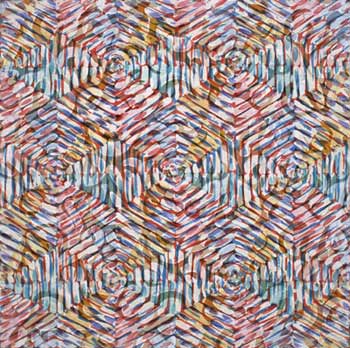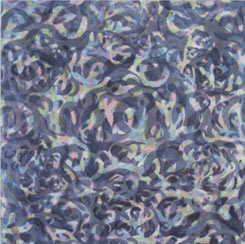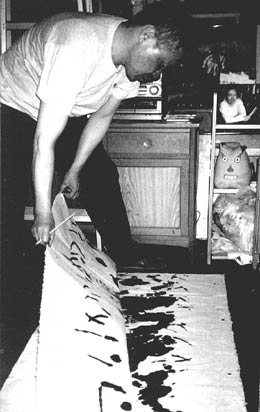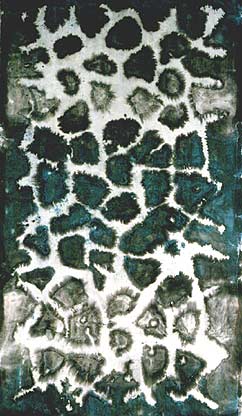BAFA © 2010. All material here is copyrighted. See conditions above. |
Liz Coats
glass, painting, Australia / New Zealand
|

Untitled painting, Sydney 1997,
pigments and gesso on canvas, 76 x 76 cm.
|
Born in New Zealand and having been based in Sydney for over 20 years, Liz Coats moved back to New Zealand in 2000.
She has had 23 solo exhibitions in Australia, New Zealand and China since 1977.
"Colour for me is both a signature and a perfume... It flavours and illumines open space, while calling attention to both distance and nearness."
See more of her work and essays at:
www.lizcoats.orcon.net.nz
|

Morphic Painting #9, 1997
pigments and gesso on canvas, 76 x 76 cm,
by Liz Coats.
|

Pentagram #8, 2000
kiln-fired elements on clear float glass,
400 x 400 cm, by Liz Coats.
|

Lattice #12, 1995
pigments and gesso on canvas, 137 x 137 cm.
|

Nature Painting, 1999
pigments and gesso on canvas,
71 x 71 cm.
|
Notes from China
by Liz Coats, New Zealand.
Part 1: Yang Gang - ‘The Great Wide Open’
In 1998 I had the opportunity to work for four months at the Beijing Art Academy in China on an Australian Asialink-sponsored residency. The painter, Yang Gang chose to be my tutor during the residency and his studio was near mine. We had no language in common, but as time passed empathy grew between us around the work we were both separately doing...
...My tutor, Yang Gang, was deeply affected by an experience of living and working with nomadic people in Inner Mongolia during the political upheavals of the 1970’s, when his initial painting studies were interrupted by the Cultural Revolution. The notebooks of sketches he made at that time are now a source for many of his paintings and he calls himself a ‘Grasslands’ artist. He also experiments with western influences in paintings on paper, and oils on canvas, but with his own bold independence...
More of the article about Yang Gang
|

Yang Gang working in his studio,1998.
Photo: Liz Coats.
|
Part 2: The Sieve, nets and everything
In the
catalogue statement for my exhibition of paintings, The Sieve, Nets and Everything at Creation Gallery in Beijing in June 1998, I responded to cross-cultural meetings as follows:
“I understand for artists, making room for our ancestors to speak to us through the work, does not necessarily mean our own family, because we all belong to a larger framework. I think you learn a lot by observing natural phenomena everywhere, for instance in nature, where living patterns are not disturbed. You can apply this knowledge to painting. This is really a very simple idea. So that style is not an issue and you do not need to work hard to challenge tradition; you are already in the tradition of ‘seeing’. You have to keep working, not only because you want to keep learning, but because you should not let go of the net that you are
creating.”
My area of concern in painting is an objectified or reconfigured space in-between, which I present as geometric structures becoming animate. I have also described this as playing with formality and coincidence.
|
 Net #4 from the "Sieve, Nets and Everything" series
Net #4 from the "Sieve, Nets and Everything" series, ink, pigments, and gesso on Chinese paper mounted on silk, 94 x 55 cm, 1998.
by Liz Coats, Australia / New Zealand.
|
...Originally I had no intention of developing a full body of work in Beijing in the short period of four months that I was there. I hoped that by being responsive to daily events and staying open to chance (ouran), I might meet in an uncontrived fashion with something of the flavour of that environment. I was not prepared to be an obedient student, attempting to gain a facility with ink and brush painting in the Chinese manner, so I worked at a tangent, seeking an empathy with local materials and some of my own ingredients.
I decided it would be sensible to work on paper and it was natural to work with water, as this is the most characteristic element of traditional Chinese painting. I was impressed by the sensitivity and strength of Chinese papers and did not want to override this...
I watched the pigments brought from Australia and black Chinese ink spreading through gessoed paper. By brushing aqueous colour stains onto the back of a painting, bleeds, cracks and hard edges of colour showed against and through an applied resist, drying into stable forms. These lattice geometries embedded in the gesso ground were inherently formal, yet visually highly active on the top side.
Through the agency of liquid colours and ink, and against an invariant lattice, I watched these images morphise into an open mesh of figures: dancing, leaping, bridging, diving. Each painting had its own character, while bound by structural likeness to the others - a formal yet suggestive flow and resist. I value this quality highly - it speaks to me of the inherent flexibility in geometry. Although I was not responding directly to local method, I was pleased when these paintings were seen and understood by other artists. One cool-eyed professor compared their quality to candle flame. Perhaps I didn’t fully understand the metaphor, but for me, this condition of light in matter is more pervasive...
Excerpts from, Arts Dialogue, February 2001, pages 16 - 19
|
- Illustration and caption: Just Let the Wind, 2006
- Article: Notes from China, Arts Dialogue, February 2001
- Painting, Pentagram #8, Arts Dialogue, November 2002
|

Arts Dialogue, Dintel 20, NL 7333 MC, Apeldoorn, The Netherlands
email: bafa@bahai-library.com
|
|






 Net #4 from the "Sieve, Nets and Everything" series, ink, pigments, and gesso on Chinese paper mounted on silk, 94 x 55 cm, 1998.
by
Net #4 from the "Sieve, Nets and Everything" series, ink, pigments, and gesso on Chinese paper mounted on silk, 94 x 55 cm, 1998.
by